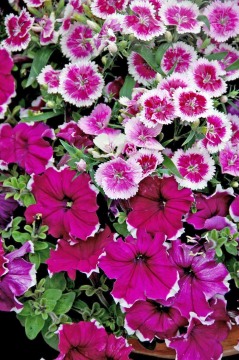Dianthus, also known as carnation, pink or sweet William is a genus that gathers 300 species. The garden carnation is a plant that blooms annually or, depending on he species, the plant can bloom all year long. The flowers can have fragrances and also several colors. If talking about hybrids, that fragrance is lacking but the variety of colors is richer.
Dianthus prefers low temperatures and this is the reason because of which it usually blooms at the beginning of winter. This plant is ideal not only as a garden flower because of the low temperatures it can resist to, but also as a vase flower, case in which, if taken cared of properly it can last even for a month.  Telstar Purple Picotee dianthus and Symphony Burgundy Picotee petunia compose a beautiful monochromatic spring garden. (Photo by Norman Winter/Mississippi State University horticulturist)
Telstar Purple Picotee dianthus and Symphony Burgundy Picotee petunia compose a beautiful monochromatic spring garden. (Photo by Norman Winter/Mississippi State University horticulturist)
Dianthus can reach a height of 25 to 50 centimeters and it is one of the most appreciated ornamental flowers. Depending on the buyer’s preference, dianthus comes in color like: red, orange, purple, yellow, pink and white.
Dianthus needs a fertile soil with neutral pH and 4 or 5 hours of full sun per day. The soil should be moist and if the quantity of water is bigger than needed the foliaje will sooner or later turn yellow. The plant needs to be treated with a liquid fertilizer every 6 to 8 weeks in order to maintain its health.
If the growing process is done indoor, you should pay a lot of attention to the temperature and humidity of the room. Dianthus doesn’t like dry air, problem that could be solved by aspersing the leaves with water and by seating the pot in a place where it isn’t exposed to artificial sources of heat or full sun.
Dianthus is a plant that can be propagated by seeds, cuttings or layering. In the first case, the process of planting the seeds should start in spring and the seeds will germinate in an approximate period of 2-3 weeks. The easiest method of multiplying it is by layering.
The plant is sensitive to diseases like: bacterial leaf spot, bacterial wilt, bacterial slow wilt, crown gall or fascination and to several fungal diseases like: alternaria blight, anther smut, calyx rot, charcoal rot, downy mildew, fairy-ring leaf spot, fusarium bud rot, fusarium stem rot, fusarium wilt, gray mold, greasy blotch, phialophora wilt, phymatotrichum root rot, pythium root rot, phytophthora wilt, rhizoctonia stem rot, rust, sclerotinia flowerspot and southern blight.
Dianthus Pictures Gallery




